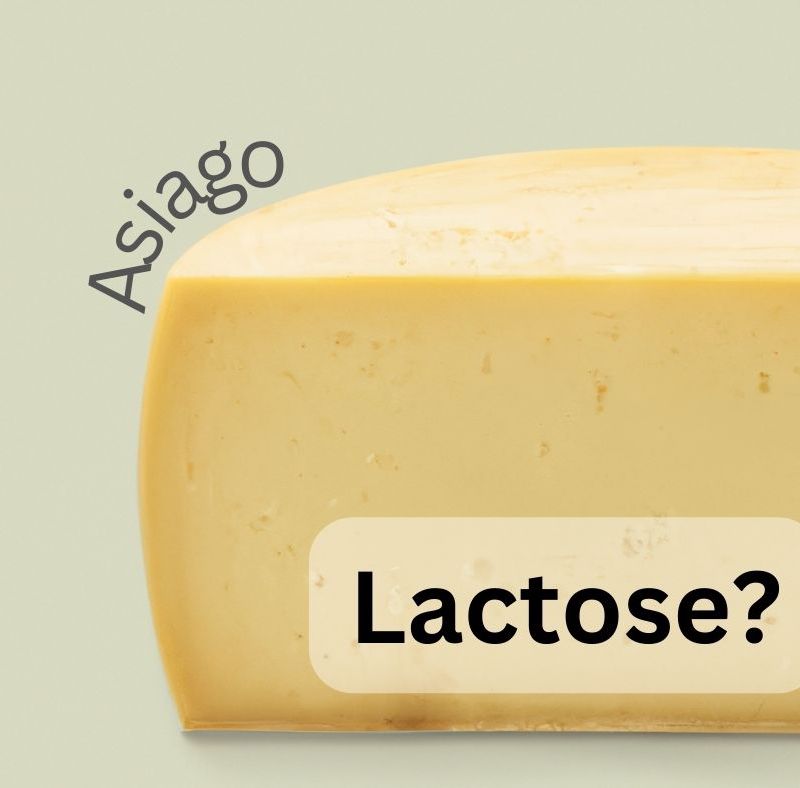Last Updated on May 29, 2023 by Aaron
If you’re living with digestive issues like irritable bowel syndrome (IBS), then you know that every day is a balancing act. You have to pay close attention to the foods you eat because even a small amount of something can cause problems.
But, what about asiago cheese? Let’s dive in.
Asiago cheese is a cow’s milk cheese produced on the Asiago plateau in the Veneto foothills in Italy.
Table of Contents
Does Asiago Cheese Have Lactose?
While asiago is not quite lactose-free, the lactose content in Asiago cheese is close to zero, especially in aged Asiago cheese.
The cheese-making process, particularly the aging process, significantly reduces lactose content. This is because the bacteria used in the fermentation process consume lactose, converting it into lactic acid. It’s similar to other hard cheeses like Parmesan, Swiss, and cheddar.
The fresh version of Asiago, known as Asiago Pressato, which is typically aged for 20-40 days, contains as little as 0.001 grams of lactose per 100 grams of cheese (1). The Asiago Consortium website reports a slightly higher figure of 0.06 grams per 100 grams.
Asiago d’Allevo, also known as aged Asiago, has an even lower lactose content. When sold as “Mezzano” at the age of four to six months, the lactose content becomes almost negligible.
As the cheese continues to age, reaching the “Vecchio” stage at ten to fifteen months, or the “Stravecchio” stage at over two years, the lactose content decreases further.
This is due to the extended aging process, which allows more time for the lactose to be broken down. Therefore, for those with lactose intolerance, you are free to enjoy Asiago cheese at any stage of aging.
Also, it’s worth mentioning that Asiago was traditionally made using sheep milk — and sheep milk is naturally having a lower concentration of lactose than cow’s milk (2). If in luck, you may still be able to find a version made with sheep’s milk.
Factors Affecting Lactose Content
Other than cheese maturation, the lactose content in cheese can also be influenced by several factors, including the type of milk used and the cheese-making process.
For instance, the diet of the cows can affect the composition of the milk, including its lactose content. Pasture feeding, for example, has been shown to alter the nutrient profile of milk (3).
The cheese-making process also plays a significant role — especially true for the non-PDO version of Asiago. During the production of Asiago cheese, the curd is heated and the whey is drained off, and pressed for 12 hours, which helps to reduce the lactose content.
Some other productions may involve curd washing or diluting the whey — a similar method in Colby or cheddar making, which will reduce the lactose content.
Asiago Cheese: Low in FODMAP?
If you’re someone who’s juggling life with IBS, you’ll be pleased to know that Asiago cheese is low-FODMAP — meaning it contains minimal amounts of certain types of carbohydrates that can trigger digestive discomfort.
High FODMAPs food can be hard to digest for people with gut issues. But Asiago cheese? It’s got your back.
It contains less than 1 gram of carbohydrate (which includes lactose) per standard serving slice. This means it’s less likely to trigger your IBS symptoms. Now, isn’t that a relief?
Furthermore, according to the Monash University FODMAP (via App), a leading authority on the FODMAP diet, Asiago cheese is low FODMAP in servings of 1/3 cup (40 g) per sitting (4). Servings of 4 cups (500 g) or more are high in the FODMAP lactose.
However, it’s important to note that individual tolerance to FODMAPs can vary.
Apart from that, Asiago cheese is a powerhouse of nutrients. It’s rich in calcium and protein, making it a great addition to your diet. Read more in asiago nutrition.

Lactose-free Asiago: Brands and Alternatives
While there isn’t a universally accepted definition for “lactose-free,” it typically refers to products with lactose levels below the detection limit of 0.0024 g per 100g, or a lactose concentration below 0.1% for products labeled as lactose-free (5).
Many popular U.S. Asiago cheese brands, such as BelGioioso, Stella, Sartori, Alma Gourmet, and Briata, do not explicitly state the lactose content on their websites or other available resources.
Cello, however, claims that their Asiago cheese is “naturally lactose-free”, containing only a negligible amount of lactose.
For those who are sensitive to lactose or prefer to avoid it, consider substituting Asiago with similar Italian cheeses, such as lactose-free Parmesan, which is readily available.
Alternatively, popular brands like Cabot Creamery and Green Valley Organics offer a variety of lactose-free cheeses, although they do not specifically offer Asiago. Some of these cheeses are treated with lactase enzymes to completely break down lactose.
For a healthier alternative, consider plant-based milk products like almond, soy, or rice milk, which naturally do not contain lactose.

